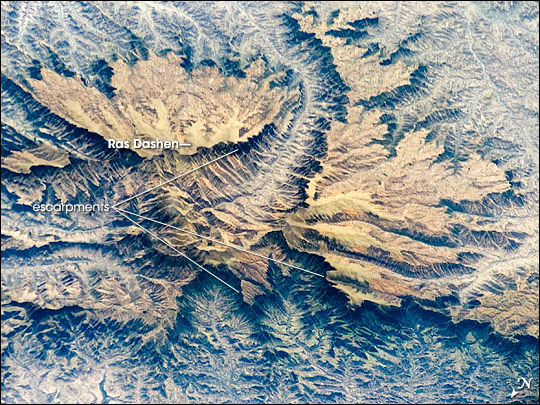
The campaigns were originally documented on a throne at Adulis in the 3rd century but it only survives in the 6th century copy by Cosmas but this again is preserved in a 8th-10th century manuscripts.
The below is the inscription about the campaigns and source is “Aksum: An African Civilisation of Late Antiquity".
". . . and after I had commanded the peoples near my country to maintain the peace, I entered valiantly into battle and subdued the following peoples; I fought the Gaze, then the Agame and the Siguene, and, having conquered, I reserved for myself half of their lands and their peoples. The Aua and Singabene and Aggabe and Tiamaa and Athagaous (meaning Agaw) and Kalaa and the Samene (Semien Mountian People) people who live beyond the Nile in inaccessible mountains covered with snow where tempests and cold are continuous and the snow so deep that a man sinks up to the knees,
Photo of Semien Mountian Snow.


I reduced to submission after having crossed the river; then the Lasine, and Zaa and Gabala, who inhabit very steep mountains where hot springs rise and flow; and the Atalmo and the Beja and all the people who erect their tents with them. Having defeated the Taggaiton who dwell up to the frontiers of Egypt I had a road constructed going from the lands of my empire to Egypt.
"Then I fought the Annine and the Metine who live on precipitous mountains as well as the people of Sesea. They took refuge on an inaccessible peak, but I besieged them on all sides and captured them, and chose among them young men and women, boys and virgins. I retained also their goods.
"I defeated also the barbarian people of Rauso who live by the aromatics trade, in immense plains without water, and the Solate, whom I also defeated, imposing on them the task of guarding the sea-lanes.
"After I had vanquished and conquered, in battles wherein I personally took part, all these peoples so well protected by their impenetrable mountains, I restricted myself to imposing tribute on them and voluntarily returning their lands. But most peoples submitted of their own free will and paid me tribute.
"I sent an expedition by sea and land against the peoples living on the other side of the Erythraean Sea, that is the Arabitas and the Kinaidokolpitas, and after subjugating their kings I commanded them to pay me tribute and charged them with guaranteeing the security of communications on land and sea. I conducted war from Leuke Kome to the land of the Sabaeans.
"I am the first and only of the kings my predecessors to have subdued all these peoples by the grace given me by my mighty god Ares, who also engendered me. It is through him that I have submitted to my power all the peoples neighbouring my empire, in the east to the Land of Aromatics, to the west to the land of Ethiopia and the Sasou; some I fought myself, against others I sent my armies.
"When I had re-established peace in the world which is subject to me I came to Adulis to sacrifice for the safety of those who navigate on the sea, to Zeus, Ares and Poseidon. After uniting and reassembling my armies I set up here this throne and consecrated it to Ares, in the twenty-seventh year of my reign."
About some of the names in the text, the same source says,
The 8th to 10th century manuscripts in which this inscription is preserved have some explanatory glosses about some of these names; thus Gaze apparently means the Aksumites, still called Agaze, the Siguene are the Suskinitai, the tribes near Adulis are called the Tigretes (the earliest mention of Tigray?), the Tiamaa are the Tziamo and Gambela, the Atalmo and Beja are the Blemmyes, the Taggaitai (Tangaitai) are also called Attabite.. and Adra..s, the Sesea are tribes of Barbaria, the Solate are those living by the sea in Barbaria, called the Tigretai of the coast in Barbaria, and Sasou is the furthest part of Ethiopia, beyond which lies the ocean and the Barbareotes who traffic in incense.
Edit: Cosmas though the King was Ptolemy of Egypt but in truth it was an Adulite.